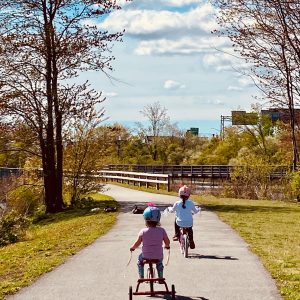 ENJOYING THE TRAIL TODAY
ENJOYING THE TRAIL TODAY
The Alfred J. Lima Quequechan River Rail Trail cuts directly through Fall River’s urban center and offers a scenic adventure for walkers, runners and bikers alike. The trail, which is a little less than two miles from start to finish, consists of a paved pathway over a former railroad bed and crosses five timber bridges alongside multiple ponds and marshes. In the warmer months, the trail is busy with families and residents of all ages enjoying the views of ducks, swans, turtles and other local wildlife. The trail’s flat surface makes it perfect for those with strollers or mobility concerns.
The Alfred J Lima Quequechan River Rail Trail can be accessed at multiple points. Parking is available at the trails start along the South Watuppa Pond, along Route 6 near the Fall River-Westport town line. Parking is also available at Britland Park, which offers facilities for soccer, tennis, and basketball, along with Fall River’s new “Fitness Court”- a free outdoor gym offering interactive workout options. Britland Park’s amenities and proximity to the Trail have made it a bustling center for athletic activity in Fall River.
HISTORY 
Fall River is a city characterized by its unique combination of industrial history and natural resources. While it is often pictured as an urban community, Fall River is surrounded by bodies of water and contains hundreds of acres of protected forestland.
In few places are industry and nature seen so closely together as on the Alfred J. Lima Queuechan Rail Trail. The trail follows the path of the Quequechan River, a body of water running East to West, connecting the Watuppa Pond to the Taunton River. The Quequechan was one of the main reasons for Fall River’s powerful growth in the 19th century, as factories harnessed the river’s powerful waters for industrial purposes.
Before the mills and factories, the area surrounding the Quequechan River was inhabited by the Wampanoag and other indigenous communities. The Quequechan River, meaning “falling water” in the Wampanoag language, played a crucial role in the lives of the native people. It served as a source of sustenance and shaped the landscape that would later become Fall River.
The Quequechan River has been changed and partially covered over the course of the last several centuries due to the growth of industry in Fall River. To protect and respect the remaining natural resources, a movement grew to create a walking trail along the existing portions of the Quequechan. The trail is named after Alfred J. Lima, a community leader, urban planner and dedicated advocate who spearheaded the effort to build it.
ARTISTIC ADVENTURES ON THE TRAIL
 Beyond the opportunities to enjoy nature or stay fit, the Rail Trail offers several highlights of Fall River’s growing arts & culture scene. FABRIC Arts Festival, a regional contemporary art event founded in Fall River, has made several investments in the area. A large sculptural bench is installed along the main path and, on the trail’s “spur” (connecting it to Rodman Street), you can find several sculptures made of glazed ceramic tiles from Portugal. A portion of this “spur” brings walkers and bikers under an overpass where there is now a “living art wall”, a constantly evolving showcase of street art. The wall, created during the 2022 edition of FABRIC, provides an open and accessible platform for Fall River’s talented street artists.
Beyond the opportunities to enjoy nature or stay fit, the Rail Trail offers several highlights of Fall River’s growing arts & culture scene. FABRIC Arts Festival, a regional contemporary art event founded in Fall River, has made several investments in the area. A large sculptural bench is installed along the main path and, on the trail’s “spur” (connecting it to Rodman Street), you can find several sculptures made of glazed ceramic tiles from Portugal. A portion of this “spur” brings walkers and bikers under an overpass where there is now a “living art wall”, a constantly evolving showcase of street art. The wall, created during the 2022 edition of FABRIC, provides an open and accessible platform for Fall River’s talented street artists.
